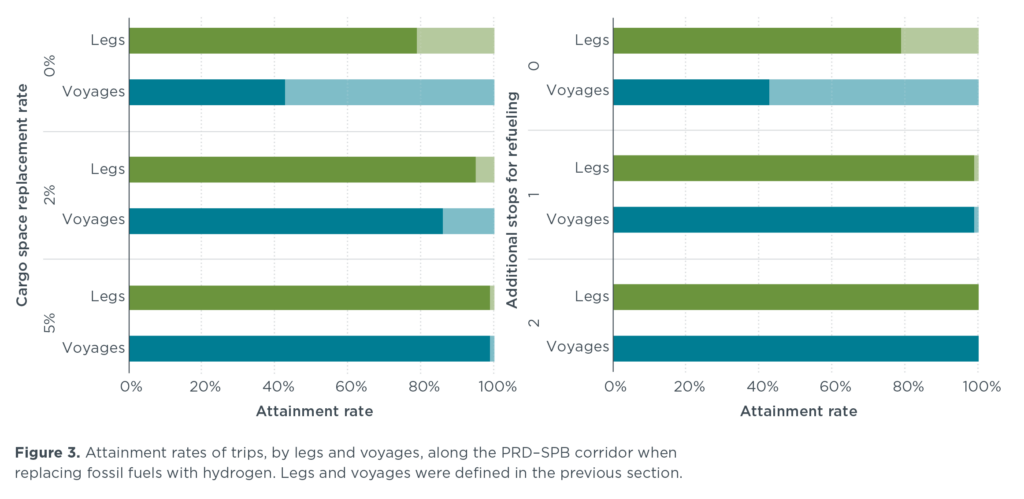In July 2019, the ICCT hosted an international workshop on zero-emission vessel technology for shipping, during which participants identified hydrogen fuel cells as a promising technology. To assess the potential, this study presents the energy demand and fuel storage space requirements of container ships servicing a corridor from China to the US.
The authors find that 99% of the voyages made along the corridor in 2015 can be fueled by hydrogen with only minor changes to fuel capacity or operations, like replacing 5% of cargo space with more hydrogen fuel or by adding one additional port of call to refuel. What is more, a large portion of the 2015 voyages, namely 43%, can be made without such changes.
Achieving even the minimum ambition of the International Maritime Organization’s initial greenhouse gas strategy will require new technologies and fuels to power ships, and these results show that the bunkering needs of some of the largest ships in the world can be met with hydrogen with only minor changes to operations
ICCT comments.
Other potential alternative fuels, including ammonia and methanol, carry more energy per unit volume than hydrogen and thus are also promising areas for future research, as are other shipping corridors.

Results explained
304 individual container ships completed 1,246 voyages along the PRD–SPB corridor in 2015. All ships were equipped with slow-speed diesel engines that burn HFO. These ships require enormous amounts of energy to operate. The average installed main engine power of ships in the fleet is around 60 megawatts. Their fuel tanks are enormous and range from 2,000–10,000 cubic meters. An average ship burns more than 70 tonnes of HFO per day.
Among the 1,246 voyages completed in 2015, 271, or 22%, were non-stop. The majority of nonstop voyages, 90%, were completed by medium- or large-size ships of between 5,000 and 11,999 TEUs. Most voyages had multiple legs. On average, ships called two ports during one voyage, and thus there were three legs to the voyage. A typical nonstop voyage was approximately 6,600 nautical miles (nm), but ships with multiple interim port calls still travelled long-range legs of 6,000 nm–6,600 nm, which means those interim ports were close to either their origin or destination.
Overall, the fleet used 75 ports of call. Besides the origin and destination ports, the most visited port in China was the Port of Kaohsiung with 12% of all stops; additionally, the most frequented interim port in the US was the Port of Oakland with 9% of all stops. The ports of call commonly used outside of China and the United States were ports in Japan, South Korea, and Russia.
Although the 1,246 voyages were different in many ways, the study reports some general patterns along the PRD–SPB corridor. All northward routes were in the two largest clusters, clusters 1 and 2, which contain 62% of ships servicing 60% of all voyages. A typical non-stop voyage of the two clusters averaged around 6,500 nm. Because of the Earth’s curvature, the great circle distance on the PRD–SPB route tends to be shorter toward northern latitudes. Still, the report observes some ships taking the southern voyage, which is typically 1,000 nm longer.
If ships traveling along the PRD–SPB corridor were powered by hydrogen fuel cells, there would need to be enough hydrogen on board to support a continuous trip between two ports of call. The study found that of the 3,624 legs completed by the 304 ships in the fleet, 2,639 or 79% of them could also be attained if the ship were powered by hydrogen fuel cells. This is without increasing the fuel tank volume or adding more ports of call. However, for voyages, the attainment rate falls significantly, to 43%. This is due to the fact that most of the attained legs are short and most voyages would contain at least one longrange leg.
Medium-size container ships are more capable of servicing this corridor when powered by hydrogen. Smaller container ships of less than 3,000 TEUs and larger ones of more than 12,000 TEUs do not have enough space for large enough fuel tanks to complete long-distance legs unless they replace some cargo space with fuel or add an additional port of call.
Finally, the more stops along a voyage, the easier it is for ships to carry enough hydrogen to complete each leg and the entire voyage. Non-stop voyages have the lowest attainment rates and those with multiple ports of call are easier for hydrogen-fueled ships to service. This is simply because of the fact that the more fragmented the voyage, the shorter the distance a ship has to travel continuously and the more opportunities there are to refuel.
Improvement of attainment rates
The number of voyages that can be attained by hydrogen-powered ships can be increased above 43% by replacing some cargo space with fuel. Replacing 2% of cargo space with fuel, or about 120 containers for a medium-size container ship, the voyage attainment rate doubles to 86%.
If 5% of the ships’ cargo space, or about 300 containers, can be substituted for fuel storage, the service fleet can complete almost all voyages.
Alternatively, ships can refuel more often. According to the report, of the 304 container ships studied, 69 of them, or 23%, can attain all of their 2015 voyages without replacing cargo space with fuel and without extra refueling stops. By calling one additional port to refuel, all but three voyages made by three ships could be attained.
See more information in the following PDF





























































